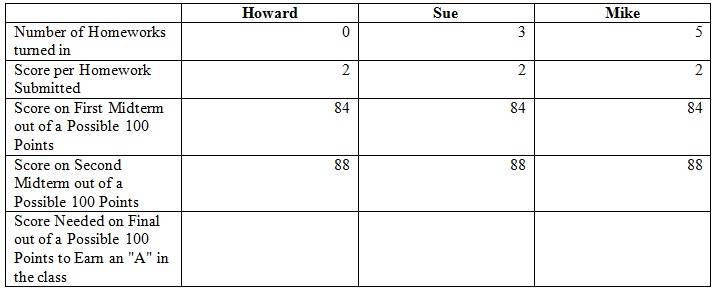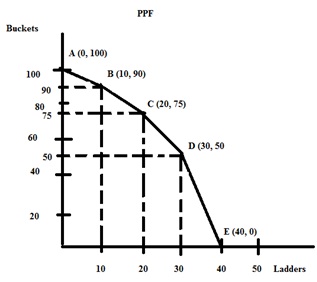Question 1.
a. Suppose you know that the two points (X, Y) = (12, 6) and (15, 3) sit on the same line. From this information write an equation for this line in slope-intercept form.
b. Suppose that you know that the slope of the line is 5 and that this line also contains the point (20, 25). What is the y-intercept for this line? Show your work.
c. You are given the following two equations:
Y = 10X + 100
Y = 76 – 2X
Find the solution (X, Y) for where these two equations intersect. Show your work.
d. Suppose that you know that the relationship between X and Y, where X is the variable measured on the horizontal axis, can be described by the following equation:
X = 40 – 2Y for all values of X ≥ 0
You are then told that for every Y value the X value has now increased by 10 units. Write the equation in slope-intercept form for this new line. Show your work. Hint: you might find it helpful to draw a "sketch" illustrating these two lines before you start doing your calculations.
e. Suppose that you know that the relationship between X and Y, where X is the variable measured on the horizontal axis, can be described by the following equation:
Y = 10 + 4X for all values of X ≥ 0
You are then told that for every X value the Y value has now decreased by 20 units. Write the equation in slope-intercept form for this new line. Show your work. Hint: you might find it helpful to draw a "sketch" illustrating these two lines before you start doing your calculations.
Question 2. More math review:
Consider three individuals who are enrolled in Professor Kelly's Econ 101 class: Howard, Sue, and Mike. In class Professor Kelly has emphasized the importance of turning in the homework and despite this advice these three individuals have taken decidedly different approaches. Professor Kelly anticipates that students will need to earn a total of 90 points on a 100 point scale from the various assignments for the semesterin order to earn an A in the class. The assignments are as follows:
• Five homework assignments that are each worth 2 points: if a student turns in all five homeworks and shows good effort they will earn 10 points on that 100 point scale from this effort. If they turn in four homeworks that show good effort they will earn 8 points on that 100 point scale from this effort. And, so on. If the student turns in none of the homeworks, they will earn 0 points on that 100 point scale.
• Two midterms that contribute 25% each to their weighted score total. So, for instance if a student scores a 50 on each of these two midterms they will get 12.5 points on a 100 point scale from each of these exams (a total of 25 points on that 100 point scale from these two exams).
• A final that contributes 40% to their weighted score total. (Note that we have now accounted for 100% of that weighted score total.) If a student scores a 70 on the final, the student will get 28 points on a 100 point scale from this final.
Here is the data you have for Howard, Sue, and Mike. You are asked to calculate the score each of these individuals needs on the final exam (assume it is a 100 point final exam) in order to get an A in the class. Show your work for each calculation. For some individuals you may find that it is impossible to earn that "A" in the class.

Question 3. Suppose that there are three countries that produce popcorn (P) and juice (J): Merryland, Happyland, and Sedateland. The maximum amount of popcorn and juice each country can produce if they only produce that one good is given in the table below. Use this information to answer this set of questions. Assume that each of the three countries have constant opportunity costs with respect to the production of popcorn and juice: that is, each country has a linear production possibility frontier.

a. Given the above information, what is Sedateland's opportunity cost of producing one more unit of popcorn?
b. Given the above information, what is Happyland's opportunity cost of producing one more unit of juice?
c. Given the above information, rank these three countries in order of their comparative advantage in the production of popcorn. List the order from the country with the greatest comparative advantage to the country with the least comparative advantage.
d. Given the above information, rank these three countries in order of their comparative advantage in the production of juice. List the order from the country with the greatest comparative advantage to the country with the least comparative advantage.
e. Construct the joint PPF for these three countries if they specialize according to comparative advantage. For this joint PPF measure popcorn on the vertical axis and juice on the horizontal axis. After constructing this joint PPF, provide the coordinates of any intercept or "kink point" in your diagram. Then write the equation for each segment of the joint PPF and provide a range or domain for each segment.
f. Consider each of the production combinations given in the table below and decide whether this production combination is possible if these three countries specialize according to comparative advantage and then trade with one another. Enter your answer as a "Yes, this combination lies on the joint PPF", "Yes, this combination lies inside the joint PPF" or "No, this combination lies outside the joint PPF" in the provided column.

Question 4. Helen and Charlie produce windows (W) and doors (D). The table below provides information about how many hours of labor they need individually to produce a window or a door. Assume that they only need labor to produce these two goods and assume that both Helen and Charlie have linear PPFs.

a. Suppose that Helen and Charlie each have 40 hours a week that they can devote to producing windows and doors. In two separate graphs draw Helen's and Charlie's production possibility frontiers: label each graph clearly and completely. In your graphs, measure doors on the vertical axis and windows on the horizontal axis.
b. Given the above information, who has the comparative advantage in the production of doors? Explain your answer.
c. Given the above information, who has the comparative advantage in the production of windows? Explain your answer.
d. Given the above information, fill in the following table:

e. Based upon Helen and Charlie each having forty hours of labor available per week, construct the joint PPF for these two individuals if they decide to specialize and trade with one another. In your graph measure doors on the vertical axis and windows on the horizontal axis. Make sure that the coordinates of all kink points are identified.
f. Given the joint PPF you constructed in (c), write the equation(s) for each segment of this joint PPF. Make sure you identify either the relevant range or domain for any equation you provide.
g. Using the number line approach discussed in class show the range of acceptable trading prices for 5 windows if Helen and Charlie specialize according to comparative advantage and then trade with one another.
5. The graph below depicts the production possibility frontier for a small economy that produces only buckets (B) and ladders (L). This PPF is linear between any two adjacent points on the PPF: e.g., the PPF is linear between points A and B, between points B and C, and between points C and D….

a. Suppose this economy is currently producing at point B. What is the opportunity cost of producing one additional bucket given this information? Explain your answer. Make sure your answer provides the units of measurement.
b. Suppose that this economy is currently producing at point B. What is the opportunity cost of producing one additional ladder given this information? Explain your answer. Make sure your answer provides the units of measurement.
c. Suppose this economy is currently producing at point C. What is the opportunity cost of producing one additional bucket given this information? Explain your answer. Make sure your answer provides the units of measurement.
d. Suppose this economy is currently producing at point C. What is the opportunity cost of producing one additional ladder given this information? Explain your answer. Make sure your answer provides the units of measurement.
e. Suppose this economy is currently producing at point D. What is the opportunity cost of producing one additional bucket given this information? Explain your answer. Make sure your answer provides the units of measurement.
f. Suppose this economy is currently producing at point D. What is the opportunity cost of producing one additional ladder given this information? Explain your answer. Make sure your answer provides the units of measurement.
g. Given the above PPF, write the equation(s) for each segment of the PPF. Identify the relevant range or domain for each equation. Show your work and how you found these equations.